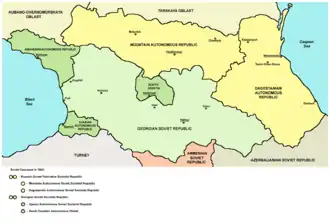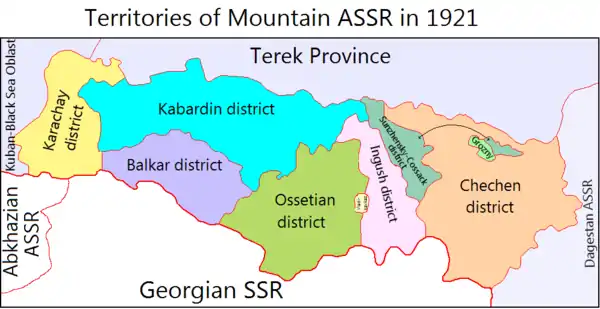Mountain Autonomous Soviet Socialist Republic
The Mountain Autonomous Soviet Socialist Republic or Mountain ASSR (Russian: Го́рская АССР, tr. Gorskaya ASSR; Chechen: Лаьмнийн Автономин Советийн Социалистийн Республика) was a short-lived autonomous republic within the Russian SFSR in the Northern Caucasus that existed from 20 January 1921, to 7 July 1924. The Mountainous Republic of the Northern Caucasus was created from parts of the Kuban and Terek Oblasts by the indigenous nationalities after the Russian Revolution; however, Soviet rule was installed on this territory after the Red Army conquered the Northern Caucasus in the course of the Russian Civil War, and the former republic was transformed into a Soviet one. The area of the republic was over 73,000 square kilometres (28,000 sq mi), and the population was about 800,000. It comprised six okrugs: Balkar, Chechen, Kabardian, Karachay, Nazran (Ingushetia), and Vladikavkaz Okrug (Ossetia)[1][2] and had two cities: Grozny and Vladikavkaz. In addition, a special autonomy was provided to the Terek Cossacks: Sunzha Cossack Okrug, which included a large enclave in northern Ingushetia, and a smaller one bordering Grozny. Its boundaries approximated those of classical Zyx.
| Mountain Autonomous Soviet Socialist Republic | |||||||||||||||||||
|---|---|---|---|---|---|---|---|---|---|---|---|---|---|---|---|---|---|---|---|
| Autonomous republic of the Russian SFSR | |||||||||||||||||||
| 1921–1924 | |||||||||||||||||||
.png.webp) Possible flag (reconstruction) | |||||||||||||||||||
 Soviet Caucasus as of 1922 | |||||||||||||||||||
| Capital | Vladikavkaz | ||||||||||||||||||
| History | |||||||||||||||||||
| • Type | Socialist republic | ||||||||||||||||||
| Historical era | Interwar period | ||||||||||||||||||
| 20 January 1921 | |||||||||||||||||||
• Annexation | 7 July 1924 | ||||||||||||||||||
| |||||||||||||||||||
The ASSR did not exist in its original state very long. Already on 1 September 1921, Kabardin Okrug was split from the ASSR as separate Kabardin Autonomous Oblast, subordinated directly to the RSFSR. Next came Karachay Okrug, which was transformed into Karachay-Cherkess Autonomous Oblast on 12 January 1922; Balkar Okrug, which was merged with Kabardin AO into Kabardino-Balkarian Autonomous Oblast on 16 January 1922; and Chechen Okrug, which was transformed into the Chechen Autonomous Oblast on 30 November 1922.
By the Decree of the VTsIK of 7 July 1924, the remaining territory of the ASSR was partitioned into the North Ossetian Autonomous Oblast and the Ingush Autonomous Oblast. The Sunzha Cossack Okrug and the city of Vladikavkaz were directly subordinated to the VTsIK until 17 October 1924, when North Caucasus Krai was formed and integrated all of the former ASSR in addition to those two units.
In the 19th century, the best land in the region was given to Cossacks, Russian and Ukrainian military colonizers, while many natives were driven to the mountains. In 1920, the Soviet government decided to deport the Terek Cossacks and give their farms to the natives. A total of 34,637 individuals were deported to Vladikavkaz, Arkhangelsk and Donbas. Hundreds of families were later found to be supporters of the Soviet government. In January 1921, the forced resettlement of the Cossacks was stopped, and some families returned to occupy abandoned farms, but the densely-populated line of Tsarist-era military settlements was erased from the North Caucasus forever and the natives were free to occupy the fertile lands on the valley floors. In 1882, 24.7% of the Ingush lived in the mountains, but by 1924 only 2.1% did.[3]
During the Cold War, many Western historians saw the disintegration of the Mountaineer Republic as a divide-and-conquer strategy by the Soviet government to keep the peoples of the Caucasus weak and subjugated to Moscow. The Soviet archives that became public in the 1990s have shown this not to be the case. The disintegration of the republic started in March 1921, just two months after its creation, when the leaders of Kabarda expressed their discontent at having been made part of the republic and cited the absence of economic links between the Kabards and other Mountaineer peoples. From April to June 1921, Kabarda held a congress at which 140 delegates, only 28 of the Bolsheviks, had overwhelmingly voted not just to become an autonomous oblast, but to also demand autonomous republic status. Joseph Stalin had to talk the leader of the Kabards, Betal Kalmykov, out of applying for a full union republic status.[4]

References
- Всероссийский Центральный исполнительный комитет. Декрет от 20 января 1921 г. «Об Автономной Горской Социалистической Советской Республике». (All-Russian Central Executive Committee. Decree of January 20, 1921 On the Autonomous Mountain Socialist Soviet Republic. ).
- Даудов 2012, p. 32.
- Alex Marshall (2010). The Caucasus Under Soviet Rule. Routledge. pp. 175–178. ISBN 9781136938252.
- Alex Marshall (2010). The Caucasus Under Soviet Rule. Routledge. p. 181. ISBN 9781136938252.
Bibliography
- Даудов, А. Х. (2012). "Государственное устройство Горской АССР" [The state structure of the Mountain ASSR]. Вестник Санкт-Петербургского университета (in Russian). СПб.: Санкт-Петербургский государственный университет (1): 31–41. ISSN 1812-9323.
{{cite journal}}: CS1 maint: location (link)